Spatial Strategies for the Renewable Energy Transition: Integrating Solar Photovoltaics into Barcelona’s Urban Morphology
Abstract
1. Introduction
- Quantify solar potential across varied urban morphologies;
- Optimise PV layout through clustering techniques;
- Deliver practical strategies for sustainable, economically viable urban energy design.
2. State-of-the-Art Review
3. Methodology Overview
3.1. Neighbourhood Morphology and 3D Modelling
3.2. Solar Radiation, Electricity Modelling, and Geometrical Placement of PV Panels
3.3. Submodule Integration and Power Optimisation
3.4. Shading Loss Factors and SPPA Viability
3.5. Financial Model Analysis
3.6. Optimisation Assumptions, Scenarios, and Strategies
- (a)
- Small modules, 0.36 × 1 m2;
- (b)
- Small modules with rotation, small modules optimised by adjusting the neighbourhood’s optimal deviation angle as an added variable;
- (c)
- Medium modules, 1 × 2.5 m2;
- (d)
- Large modules, 2.5 × 10 m2;
- (e)
- Generation (Gen) 10.5 (extra-large modules, 2.94 m × 3.37 m);
- (f)
- Common medium module size, maintaining a medium module while optimising other variables;
- (g)
- The standard spacing configuration is based on minimum solar altitude at partial shading times (e.g., 21 December, 9 a.m./3 p.m.);
- (h)
- Standard fixed tilt-orientation configuration. Assumes a 31.5° tilt and 180° orientation (south-facing) in Barcelona while optimising other variables.
3.7. Clustering Strategy
3.8. Multi-Objective Optimisation
- Building and roof setup: defining geometry, orientation, and shading.
- PV configuration: applying a 31.5° tilt, with specified module sizes and spacing.
- Panel layout generation: simulating layouts based on usable area.
- Solar radiation and mesh analysis: assessing irradiation using local weather data to filter suboptimal zones.
- Utility cost modelling: incorporating real electricity tariffs, usage patterns, and seasonal variation.
- Final optimisation: identifying configurations that balance energy, cost, and return within the SPPA framework.
4. Results with Analytical Insights
4.1. Modular Segmentation and Urban Form Analysis
4.2. Small Module Scenario as Baseline Configuration and Energy Analysis
4.3. Total Energy Production Calculation Process
4.4. Analysing the Effects of Hypothetical Neighbourhood Rotation on Utility Bills and Shading
4.5. Weighted Average Methodology
4.6. Clustering Analysis
4.7. Impacts of PV Module Efficiency and Area on Energy and Financial Performance
4.8. Impact of Eliminating PV Panels
5. Discussion and Conclusions
5.1. Scenario-Based Evaluation: La Vila Olímpica Case
5.2. Submodule Integrated Converter (SubMICs+) Strategy and Module Optimisation
5.3. Broader Urban Implications
5.4. Limitations and Future Work
Supplementary Materials
Author Contributions
Funding
Institutional Review Board Statement
Informed Consent Statement
Data Availability Statement
Conflicts of Interest
Appendix A
References
- Salat, S.; Bourdic, L. Urban Complexity, Efficiency and Resilience. In Energy Efficiency—A Bridge to Low Carbon Economy; InTech: Rijeka, Croatia, 2012. [Google Scholar] [CrossRef]
- Perini, K.; Magliocco, A. Effects of Vegetation, Urban Density, Building Height, and Atmospheric Conditions on Local Temperatures and Thermal Comfort. Urban For. Urban Green. 2014, 13, 495–506. [Google Scholar] [CrossRef]
- Kurdgelashvili, L.; Li, J.; Shih, C.H.; Attia, B. Estimating Technical Potential for Rooftop Photovoltaics in California, Arizona and New Jersey. Renew. Energy 2016, 95, 286–302. [Google Scholar] [CrossRef]
- Wiginton, L.K.; Nguyen, H.T.; Pearce, J.M. Quantifying Rooftop Solar Photovoltaic Potential for Regional Renewable Energy Policy. Comput. Environ. Urban Syst. 2010, 34, 345–357. [Google Scholar] [CrossRef]
- Weatherbase. Available online: https://www.weatherbase.com/weather/weatherall.php3?s=18180&cityname=Barcelona%2C+Catalonia%2C+Spain&units= (accessed on 5 May 2025).
- Cheng, V.; Steemers, K.; Montavon, M.; Compagnon, R. Compact Cities in a Sustainable Manner. In Proceedings of the 2nd International Solal Cities Congress, Oxford, UK, 3–6 April 2006; pp. 1–11. [Google Scholar]
- Hernández-Mayoral, E.; Madrigal-Martínez, M.; Mina-Antonio, J.D.; Iracheta-Cortez, R.; Enríquez-Santiago, J.A.; Rodríguez-Rivera, O.; Martínez-Reyes, G.; Mendoza-Santos, E. A Comprehensive Review on Power-Quality Issues, Optimization Techniques, and Control Strategies of Microgrid Based on Renewable Energy Sources. Sustainability 2023, 15, 9847. [Google Scholar] [CrossRef]
- Aelenei, L.S. Integrated Photovoltaics: An Opportunity for Urban Decarbonization. Future City 2020, 18, 17–34. [Google Scholar] [CrossRef]
- Sharma, P.; Mehlawat, M.K.; Gupta, P.; Pamucar, D. Cluster-Based Decision Making: A Novel Approach for Handling Large-Scale Alternatives in Rooftop Solar PV Site Selection. Artif. Intell. Rev. 2025, 58, 113. [Google Scholar] [CrossRef]
- Gassar, A.A.A.; Cha, S.H. Review of Geographic Information Systems-Based Rooftop Solar Photovoltaic Potential Estimation Approaches at Urban Scales. Appl. Energy 2021, 291, 116817. [Google Scholar] [CrossRef]
- Ahmed, S. The American University in Cairo Environmental Engineering Program Estimating Solar Energy Production in Urban Areas for Electric Vehicles. Master’s Thesis, The American University in Cairo, Cairo, Egypt, 2023. [Google Scholar]
- Aboushal, E.A. Applying GIS Technology for Optimum Selection of Photovoltaic Panels “Spatially at Defined Urban Area in Alexandria, Egypt”. Alexandria Eng. J. 2018, 57, 4167–4176. [Google Scholar] [CrossRef]
- Gilman, P.; Dobos, A.; DiOrio, N.; Freeman, J.; Janzou, S.; Ryberg, D. System Advisor Model (SAM) Photovoltaic Model Technical Reference Update; National Renewable Energy Laboratory: Golden, CO, USA, 2018. [Google Scholar]
- Curreli, A. How Environmental and Energy Issues Shape the Cities: A Case-Study in Barcelona, Spain. In Proceedings of the Cities in Transformation: Research & Design Ideas, Methods, Techniques, Tools, Case Studies Conference, Milano, Italy, 7–10 June 2012. [Google Scholar]
- Skeie, K.S.; Rokseth, L.S.; Lausselet, C.; Gustavsen, A. Characterizing and Structuring Open Datasets for Assessment of Residential Building Energy Use on the Neighborhood and Urban Scale. Energy Build. 2025, 341, 115842. [Google Scholar] [CrossRef]
- Sicilia, Á.; Madrazo, L.; Massetti, M.; Plazas, F.L.; Ortet, E. An Energy Information System for Retrofitting Smart Urban Areas. Energy Procedia 2017, 136, 85–90. [Google Scholar] [CrossRef]
- Wang, Y.; Gao, W.; Gong, M.; Li, H.; Xie, J. A New Two-Stage Based Evolutionary Algorithm for Solving Multi-Objective Optimization Problems. Inf. Sci. 2022, 611, 649–659. [Google Scholar] [CrossRef]
- Toward Data Sciences. Available online: https://towardsdatascience.com/understanding-k-means-clustering-in-machine-learning-6a6e67336aa1 (accessed on 5 May 2025).
- IEA. Spain’s Solar Power Policy Framework: IEA Survey. Available online: https://reglobal.org/spains-solar-power-policy-framework-iea-survey/ (accessed on 5 May 2025).
- Spain Abolishes the ‘Tax on the Sun’|Greentech Media. Available online: https://www.greentechmedia.com/articles/read/spain-abolishes-the-tax-on-the-sun#gs.9aac4y (accessed on 2 May 2019).
- Comisión Nacional de los Mercados y la Competencia. Spanish Energy Regulator’s National Report to the European Commission 2018; Comisión Nacional de los Mercados y la Competencia: Madrid, Spain, 2018. [Google Scholar]
- Li, Y.; Beeton, R.J.S.; Zhao, X.; Fan, Y.; Yang, Q.; Li, J.; Ding, L. Advancing Urban Sustainability Transitions: A Framework for Understanding Urban Complexity and Enhancing Integrative Transformations. Humanit. Soc. Sci. Commun. 2024, 11, 1–14. [Google Scholar] [PubMed]
- Xu, Y.; Ren, C.; Ma, P.; Ho, J.; Wang, W.; Lau, K.K.L.; Lin, H.; Ng, E. Urban Morphology Detection and Computation for Urban Climate Research. Landsc. Urban Plan. 2017, 167, 212–224. [Google Scholar] [CrossRef]
- Rhino. Available online: https://www.rhino3d.com/ (accessed on 5 May 2025).
- Grasshopper. Available online: http://www.grasshopper3d.com/ (accessed on 5 May 2025).
- Food4rhino. Available online: https://www.food4rhino.com/en (accessed on 5 May 2025).
- EnergyPlus. Available online: https://energyplus.net/ (accessed on 5 May 2025).
- Morganti, M.; Salvati, A.; Coch, H.; Cecere, C. Urban Morphology Indicators for Solar Energy Analysis. Energy Procedia 2017, 134, 807–814. [Google Scholar] [CrossRef]
- ESRI. Available online: https://www.esri.com/en-us/arcgis/about-arcgis/overview (accessed on 5 May 2025).
- Schallenberg-Rodríguez, J. Photovoltaic Techno-Economical Potential on Roofs in Regions and Islands: The Case of the Canary Islands. Methodological Review and Methodology Proposal. Renew. Sustain. Energy Rev. 2013, 20, 219–239. [Google Scholar] [CrossRef]
- EnSims. Available online: https://app.ensims.com/epw/ (accessed on 5 May 2025).
- Michalsky, J. The Astronomical Almanac’s Algorithm for Approximate Solar Position (1950–2050). Sol. Energy 1988, 40, 227–235. [Google Scholar] [CrossRef]
- Khoo, Y.S.; Nobre, A.; Malhotra, R.; Yang, D.; Ruther, R.; Reindl, T.; Aberle, A.G. Optimal Orientation and Tilt Angle for Maximizing In-Plane Solar Irradiation for PV Applications in Singapore. IEEE J. Photovolt. 2014, 4, 647–653. [Google Scholar] [CrossRef]
- Ma, X.S.; Yao, G.H.; Ye, L.J.; Zhi, X.F.; Zhang, S.M. Distance Calculation between Photovoltaic Arrays Fixed on Sloping Ground. J. Comput. Methods Sci. Eng. 2015, 15, 107–116. [Google Scholar] [CrossRef]
- Byrne, J.; Taminiau, J.; Kurdgelashvili, L.; Kim, K.N. A Review of the Solar City Concept and Methods to Assess Rooftop Solar Electric Potential, with an Illustrative Application to the City of Seoul. Renew. Sustain. Energy Rev. 2015, 41, 830–844. [Google Scholar] [CrossRef]
- Deline, C.; Meydbray, J.; Donovan, M. Photovoltaic Shading Testbed for Module-Level Power Electronics: 2016 Performance Data Update; National Renewable Energy Laboratory: Golden, CO, USA, 2016. [Google Scholar]
- Deline, C.; Sekulic, B.; Stein, J.; Barkaszi, S.; Yang, J.; Kahn, S. Evaluation of Maxim Module-Integrated Electronics at the DOE Regional Test Centers. In Proceedings of the 2014 IEEE 40th Photovoltaic Specialist Conference (PVSC), Denver, CO, USA, 8–13 June 2014; pp. 986–991. [Google Scholar] [CrossRef]
- Dobos, A. PVWatts Version 5 Manual—Technical Report; NREL/TP-6A20-62641; National Renewable Energy Laboratory: Golden, CO, USA, 2014. [Google Scholar]
- Takebayashi, H.; Ishii, E.; Moriyama, M.; Sakaki, A.; Nakajima, S.; Ueda, H. Study to Examine the Potential for Solar Energy Utilization Based on the Relationship between Urban Morphology and Solar Radiation Gain on Building Rooftops and Wall Surfaces. Sol. Energy 2015, 119, 362–369. [Google Scholar] [CrossRef]
- Doubleday, K.; Choi, B.; Maksimovic, D.; Deline, C.; Olalla, C. Recovery of Inter-Row Shading Losses Using Differential Power-Processing Submodule DC-DC Converters. Sol. Energy 2016, 135, 512–517. [Google Scholar] [CrossRef]
- Solaredge Technical Note Bypass Diode Effects in Shaded Conditions. 2010. Available online: https://knowledge-center.solaredge.com/sites/kc/files/se_technical_bypass_diode_effect_in_shading.pdf (accessed on 5 May 2025).
- Silvestre, S.; Boronat, A.; Chouder, A. Study of Bypass Diodes Configuration on PV Modules. Appl. Energy 2009, 86, 1632–1640. [Google Scholar] [CrossRef]
- Kerekes, T.; Koutroulis, E.; Séra, D.; Teodorescu, R.; Katsanevakis, K. An Optimization Method for Designing Large PV Plants. IEEE J. Photovolt. 2013, 3, 814–822. [Google Scholar] [CrossRef]
- Wahhab, H.A.A. Assessment of Solar Power Tower System for Closed Space Ventilation: Numerical Investigation. IOP Conf. Ser. Mater. Sci. Eng. 2021, 1094, 012025. [Google Scholar] [CrossRef]
- Olalla, C.; Deline, C.; Maksimovic, D. Modeling and Simulation of Conventionally Wired Photovoltaic Systems Based on Differential Power Processing SubMIC-Enhanced PV Modules. In Proceedings of the 2014 IEEE 15th Workshop on Control and Modeling for Power Electronics (COMPEL), Santander, Spain, 22–25 June 2014. [Google Scholar] [CrossRef]
- Fu, R.; Feldman, D.; Margolis, R.U.S. Solar Photovoltaic System Cost Benchmark: Q1 2018; NREL/TP-6A20-72399; National Renewable Energy Laboratory: Golden, CO, USA, 2018. [Google Scholar]
- SpainAccountants. Available online: https://www.europeaccountants.com/spain/company-tax (accessed on 5 May 2025).
- Openaccessgovernment. Available online: https://www.openaccessgovernment.org/spain-suspends-solar-power-tax/53112/ (accessed on 5 May 2025).
- Steffen, B. Estimating the Cost of Capital for Renewable Energy Projects. Energy Econ. 2020, 88, 104783. [Google Scholar] [CrossRef]
- Forbes. Available online: https://www.forbes.com/sites/siemens-smart-infrastructure/2022/09/15/wireless-charging-hands-free-technology-offers-a-leap-forward-for-emobility/?sh=573d28f87b98 (accessed on 5 May 2025).
- Kuckshinrichs, W. Lcoe: A Useful and Valid Indicator—Replica to James Loewen and Adam Szymanski. Energies 2021, 14, 406. [Google Scholar] [CrossRef]
- Vartiainen, E.; Masson, G.; Breyer, C.; Moser, D.; Román Medina, E. Impact of Weighted Average Cost of Capital, Capital Expenditure, and Other Parameters on Future Utility-Scale PV Levelised Cost of Electricity. Prog. Photovolt. Res. Appl. 2020, 28, 439–453. [Google Scholar] [CrossRef]
- Bean, P.; Blazquez, J.; Nezamuddin, N. Assessing the Cost of Renewable Energy Policy Options—A Spanish Wind Case Study. Renew. Energy 2017, 103, 180–186. [Google Scholar] [CrossRef]
- Goryunova, N.N. Tax Incentives for Renewable Energy: The European Experience. Eur. Proc. Soc. Behav. Sci. 2017, 19, 507–513. [Google Scholar] [CrossRef]
- Schlosser, V.; Dineva, M.; Bajons, P.; Ebner, R.; Summhammer, J.; Klinger, G. Local Characterization of Multicrystalline Silicon Wafers and Solar Cells. In Recent Advances in Multidisciplinary Applied Physics; Elsevier: Hoboken, NJ, USA, 2005. [Google Scholar]
- David, R. Galapagos. Available online: https://www.grasshopper3d.com/profiles/blogs/evolutionary-principles (accessed on 5 May 2025).
- IEA. Energy Policy Review Spain. 2021. Internnational Energy Agency. 2019. Available online: https://iea.blob.core.windows.net/assets/2f405ae0-4617-4e16-884c-7956d1945f64/Spain2021.pdf (accessed on 5 May 2025).
- Kheiri, F. A Review on Optimization Methods Applied in Energy-efficient Building Geometry and Envelope Design. Renew. Sustain. Energy Rev. 2018, 92, 897–920. [Google Scholar] [CrossRef]
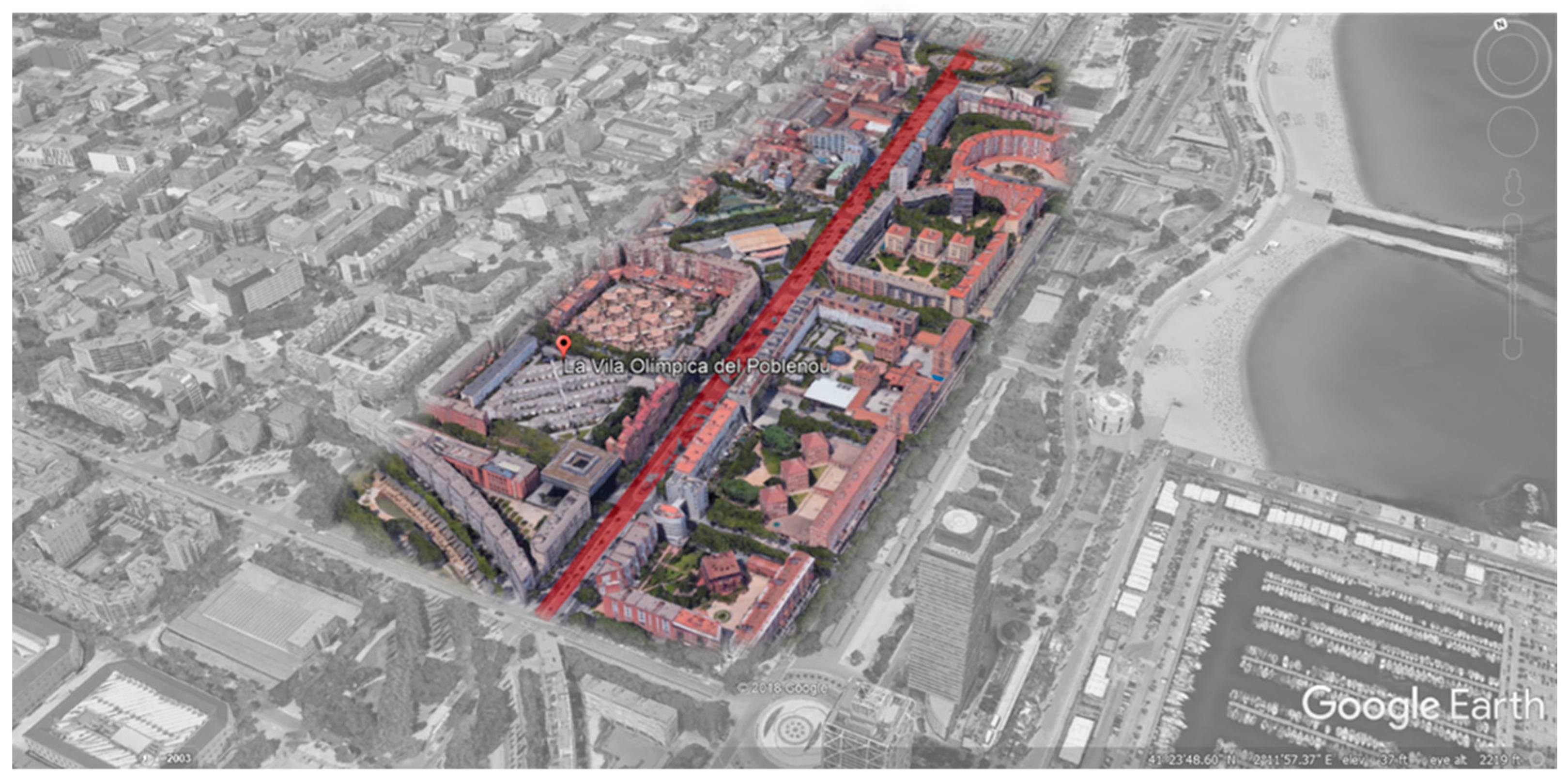


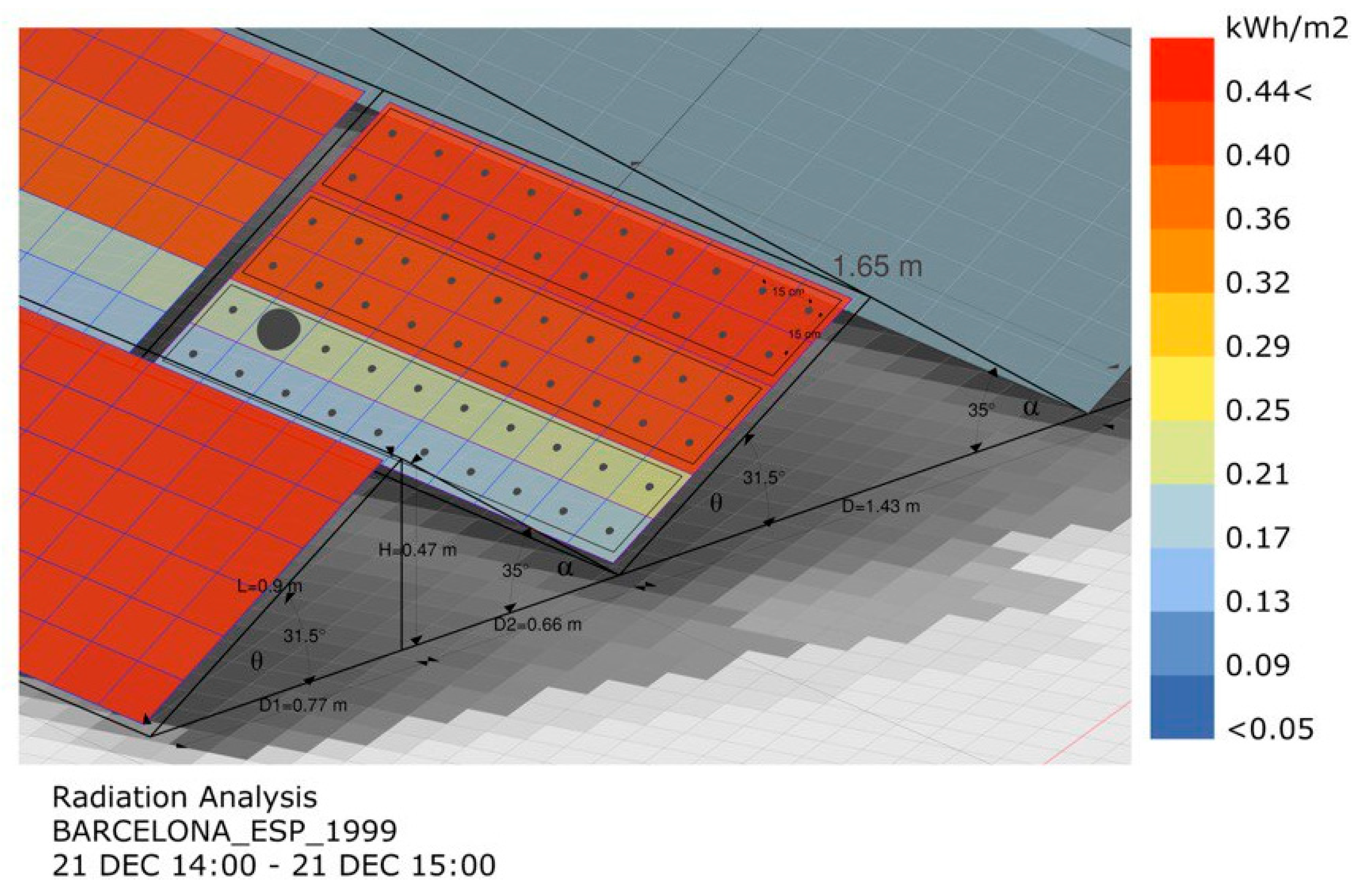
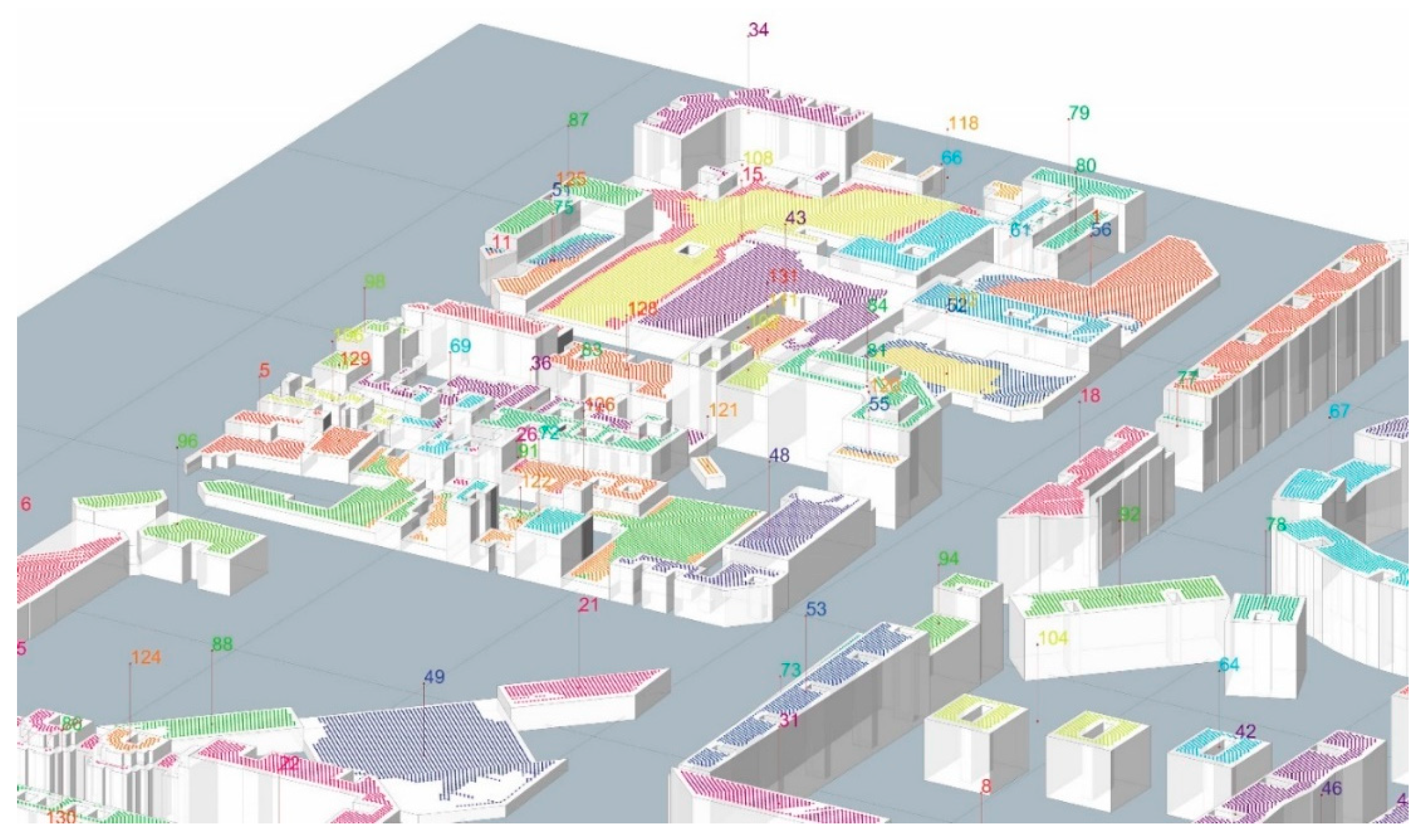


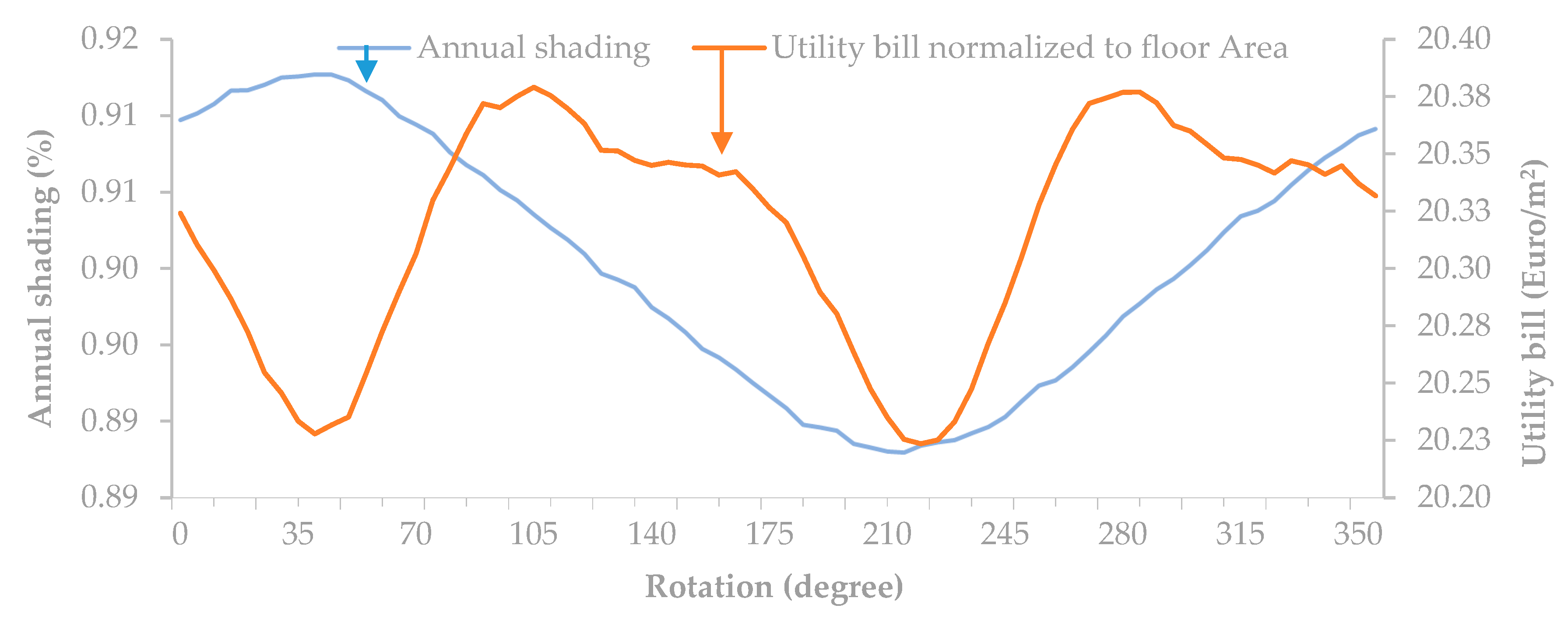
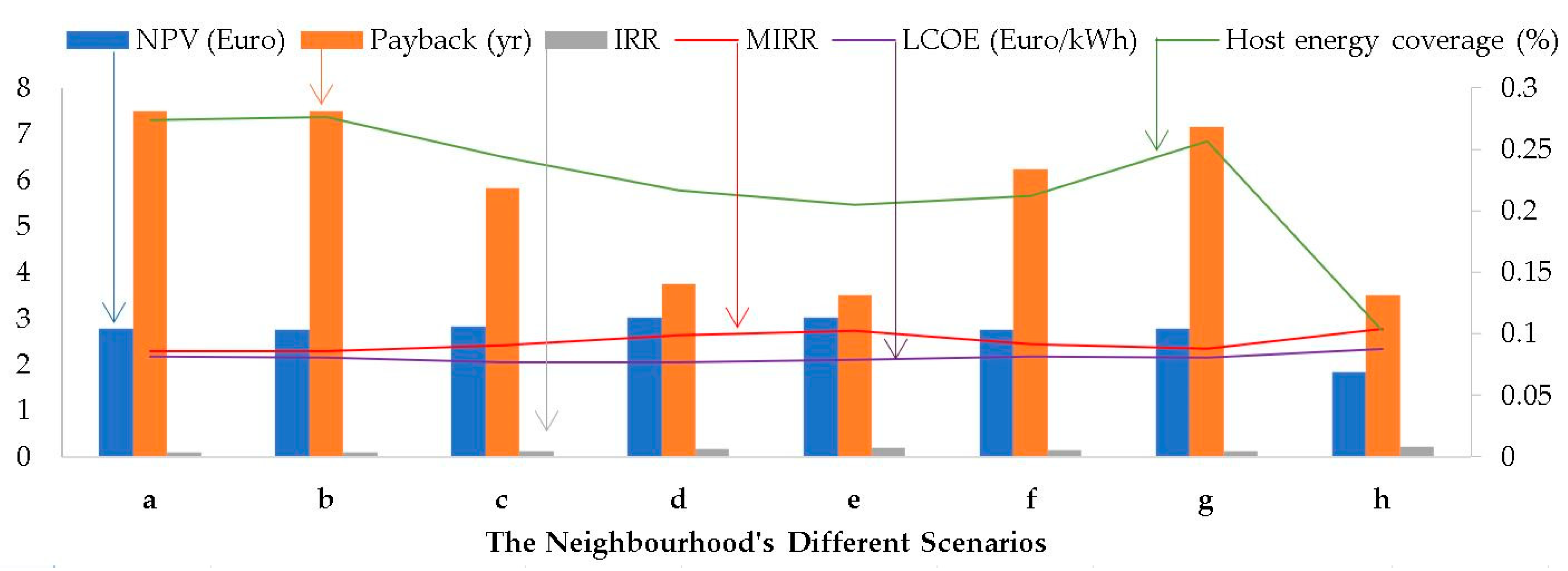
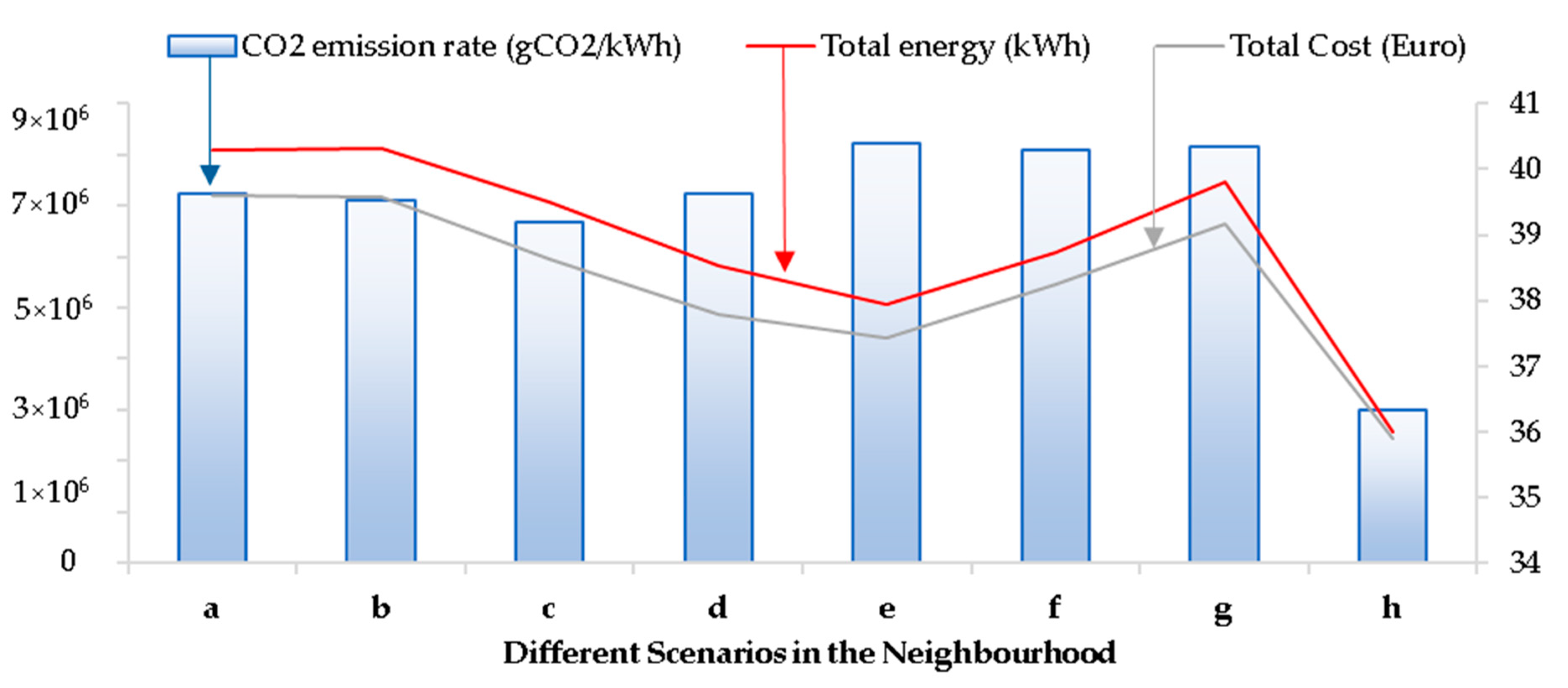

| North | |||||||||||||||||
|---|---|---|---|---|---|---|---|---|---|---|---|---|---|---|---|---|---|
| 0 | 0 | 0 | 0 | 0 | 0.63 | 1.33 | 0.08 | 0 | 0 | 0 | 0 | 0 | 0 | 0.351 | 0.623 | 0.029 | 0 |
| 0 | 0 | 0 | 0 | 0.36 | 1.6 | 1.17 | 1.12 | 0.12 | 0 | 0 | 0 | 0 | 0.236 | 0.614 | 0.707 | 0.232 | 0.018 |
| 0 | 0 | 0 | 0.55 | 0.4 | 1.17 | 1.2 | 1.29 | 1.7 | 0 | 0 | 0 | 0.182 | 0.222 | 0.501 | 0.174 | 0.196 | 0.243 |
| 0 | 0.01 | 1.29 | 1.04 | 0.45 | 0.87 | 1.12 | 0.81 | 0.46 | 0 | 0.002 | 0.235 | 0.227 | 0.395 | 0.157 | 0.191 | 0.117 | 0.054 |
| 0.05 | 1.18 | 1.03 | 1.46 | 0.74 | 1.36 | 1.1 | 0.8 | 0 | 0.007 | 0.274 | 0.376 | 0.364 | 0.137 | 0.211 | 0.279 | 0.278 | 0 |
| 2.13 | 0.89 | 0.74 | 1.26 | 1.55 | 1.64 | 0.82 | 0 | 0 | 0.356 | 0.275 | 0.226 | 0.236 | 0.251 | 0.316 | 0.332 | 0 | 0 |
| 0.85 | 1.17 | 1.32 | 0.95 | 1.09 | 0.64 | 0 | 0 | 0 | 0.135 | 0.332 | 0.251 | 0.245 | 0.415 | 0.221 | 0 | 0 | 0 |
| 0 | 1.67 | 1 | 1.25 | 0.81 | 0 | 0 | 0 | 0 | 0 | 0.239 | 0.187 | 0.337 | 0.219 | 0 | 0 | 0 | 0 |
| 0 | 0.24 | 1.54 | 0.53 | 0 | 0 | 0 | 0 | 0 | 0 | 0.034 | 0.303 | 0.151 | 0 | 0 | 0 | 0 | 0 |
| FAR | BCR | ||||||||||||||||
| a | b | c | d | e | f | g | h | |
|---|---|---|---|---|---|---|---|---|
| Tilt (degree) | 8 | 8 | 10 | 8.5 | 4 | 31.5 | 5 | 31.5 |
| Orientation (degree) | 180 | 180 | 186 | 194 | 158 | 188 | 201 | 180 |
| Minimum sun altitude angle considered for spacing calculation (degree) | 30 | 30 | 22 | 20 | 20 | 32 | Sun altitude: 6.24_sun azimuth: 128.93 | |
| Module height (m) | 0.6 | 0.6 | 1.05 | 2.25 | 3 | 1.05 | 0.9 | 1.35 |
| Module width (m) | 0.9 | 1.05 | 1.65 | 2.55 | 3.3 | 1.65 | 1.2 | 2.25 |
| PPA price (Euro/kWh) | 0.1 | 0.1 | 0.1 | 0.1 | 0.1 | 0.1 | 0.1 | 0.2 |
| Spacing (m) | 0.7 | 0.7 | 1.5 | 3.1 | 3.6 | 1.8 | 1.1 | 5.3 |
| Number of participating buildings (out of 255) | 195 | 197 | 187 | 149 | 124 | 185 | 194 | 115 |
| Avrg. system size (kW) | 48 | 39.5 | 35.5 | 37.5 | 40 | 32 | 37 | 20.15 |
| Total number of panels | 76,152 | 67,862 | 21,300 | 5355 | 2760 | 18,923 | 37,251 | 4081 |
| Avrg. installed cost (Euro/W) | 1.37 | 1.46 | 1.36 | 1.24 | 1.22 | 1.38 | 1.43 | 1.3 |
| a | b | c | d | e | f | g | h | |
|---|---|---|---|---|---|---|---|---|
| NPV (Euro) | 2.77 | 2.76 | 2.84 | 3.02 | 3.03 | 2.75 | 2.78 | 1.82 |
| Payback (yr) | 7.5 | 7.5 | 5.83 | 3.75 | 3.5 | 6.25 | 7.16 | 3.5 |
| IRR (%) | 10 | 10 | 12 | 17 | 19 | 13 | 11 | 20 |
| MIRR (%) | 8 | 8 | 9 | 9 | 10 | 9 | 8 | 10 |
| Performance ratio (%) | 63.01 | 63.2 | 63.76 | 62.98 | 61.72 | 61.84 | 61.97 | 66.81 |
| Total energy (kWh) | 8.08 × 106 | 8 × 106 | 7 × 106 | 6 × 106 | 5.07 × 106 | 6 × 106 | 7 × 106 | 3 × 106 |
| LCOE (EUR ct/kWh) | 8.0 | 8.0 | 7.0 | 7.0 | 7.0 | 8.2 | 8.1 | 8.0 |
| CO2 emission rate (gCO2/kWh) | 39.6 | 39.5 | 39.2 | 39.6 | 40.4 | 40.2 | 40.3 | 36.3 |
| Host NPV/m2 (Euro/m2) | −202.48 | −201 | −207.1 | −214.4 | −219.03 | −213.07 | −205.6 | −229.6 |
| Host energy coverage (%) | 0.27 | 0.27 | 0.24 | 0.21 | 0.2 | 0.21 | 0.25 | 0.1 |
| GCR (%) | 47.6 | 47.6 | 41.8 | 36.9 | 35.2 | 37.2 | 45.3 | 16 |
| Specific Yield (kWh/kWp) | 1043 | 1046 | 1055 | 1043 | 1022 | 1024 | 1025 | 1106 |
| CF (%) | 11.9 | 11.94 | 12.04 | 11.9 | 11.66 | 11.68 | 11.69 | 12.62 |
| Total cost (Euro) | 7.22 × 106 | 7.18 × 106 | 5.97 × 106 | 4.86 × 106 | 4.40 × 106 | 5.46 × 106 | 6.63 × 106 | 2.45 × 106 |
| O&M (Euro) | 1.10 × 106 | 1.10 × 106 | 0.95 × 106 | 0.79 × 106 | 0.70 × 106 | 0.84 × 106 | 1.04 × 106 | 0.32 × 106 |
| Inverter (Euro) | 0.74 × 106 | 0.74 × 106 | 0.61 × 106 | 0.48 × 106 | 0.42 × 106 | 0.55 × 106 | 0.68 × 106 | 0.22 × 106 |
| Capital (Euro) | 5.37 × 106 | 5.33 × 106 | 4.4 × 106 | 3.58 × 106 | 3.26 × 106 | 4.05 × 106 | 4.91 × 106 | 1.90 × 106 |
| Metrics (Weighted Average) | a | b | c | d | e | f | g | h |
|---|---|---|---|---|---|---|---|---|
| Financial | 0.3 | 0.3 | 0.34 | 0.44 | 0.47 | 0.34 | 0.31 | 0.33 |
| Energy performance | 1.03 | 1.04 | 0.9 | 0.74 | 0.65 | 0.77 | 0.95 | 0.41 |
| LCOE | 0.32 | 0.33 | 0.39 | 0.4 | 0.35 | 0.31 | 0.32 | 0.15 |
| Environmental | 1.12 | 1.12 | 1.14 | 1.12 | 1.08 | 1.09 | 1.09 | 1.29 |
| Host Financial | 0.95 | 0.97 | 0.84 | 0.52 | 0.44 | 0.54 | 0.88 | 0.19 |
| Total | 3.73 | 3.78 | 3.63 | 3.24 | 3.01 | 3.07 | 3.56 | 2.39 |
| Neighbourhood’s Configuration | Small Modules SubMICs+ Scenario |
|---|---|
| Tilt (degree) | 11 |
| Orientation from the south | 0 |
| Minimum sun altitude angle for spacing calculations | 66 |
| Module height (m) | 0.6 |
| Module width (m) | 0.9 |
| PPA price (Euro/kWh) | 0.12 |
| Spacing (m) | 0.6 |
| Number of usable buildings | 204 from 225 |
| Percentage of usable buildings to total | 60.66 |
| Avrg. system size (kW) | 39 |
| Total number of panels | 81,975 |
| Avrg. installed cost (Euro/W) | 1.47 |
| Normalised total energy (kW/m2 per yr) | 92 |
| NPV/m2 for 30 yrs | 41 |
| NPV (Euro) | 3.7 × 106 |
| PAYBACK (yr) | 6.3 |
| IRR (%) | 13 |
| MIRR (%) | 9 |
| Performance ratio (%) | 62 |
| Total energy (kWh) | 8.3 × 106 |
| LCOE (EUR ct/kWh) | 9.0 |
| CO2 emission rate (gCO2/kWh) | 40 |
| Host NPV/m2 (Euro/m2) | −205 |
| Host energy coverage (%) | 0.27 |
| GCR (%) | 49 |
| Specific yield (kWh/kWp) | 1028 |
| Capacity Factor (%) | 11.7 |
| Maximum usable roof area (m2) | 90,365 |
| Total cost (Euro) | 7.8 × 106 |
| O&M (Euro) | 1.14 × 106 |
Disclaimer/Publisher’s Note: The statements, opinions and data contained in all publications are solely those of the individual author(s) and contributor(s) and not of MDPI and/or the editor(s). MDPI and/or the editor(s) disclaim responsibility for any injury to people or property resulting from any ideas, methods, instructions or products referred to in the content. |
© 2025 by the authors. Licensee MDPI, Basel, Switzerland. This article is an open access article distributed under the terms and conditions of the Creative Commons Attribution (CC BY) license (https://creativecommons.org/licenses/by/4.0/).
Share and Cite
Roodneshin, M.; Alcojor, A.M.; Masseck, T. Spatial Strategies for the Renewable Energy Transition: Integrating Solar Photovoltaics into Barcelona’s Urban Morphology. Solar 2025, 5, 34. https://doi.org/10.3390/solar5030034
Roodneshin M, Alcojor AM, Masseck T. Spatial Strategies for the Renewable Energy Transition: Integrating Solar Photovoltaics into Barcelona’s Urban Morphology. Solar. 2025; 5(3):34. https://doi.org/10.3390/solar5030034
Chicago/Turabian StyleRoodneshin, Maryam, Adrian Muros Alcojor, and Torsten Masseck. 2025. "Spatial Strategies for the Renewable Energy Transition: Integrating Solar Photovoltaics into Barcelona’s Urban Morphology" Solar 5, no. 3: 34. https://doi.org/10.3390/solar5030034
APA StyleRoodneshin, M., Alcojor, A. M., & Masseck, T. (2025). Spatial Strategies for the Renewable Energy Transition: Integrating Solar Photovoltaics into Barcelona’s Urban Morphology. Solar, 5(3), 34. https://doi.org/10.3390/solar5030034





